Stack AI vs. SuperAGI: Comparing Low-Code and Open-Source AI Platforms
The AI development landscape has transformed, offering powerful tools to create intelligent applications without extensive coding. Stack AI vs. SuperAGI stand out as two distinct platforms, each with unique strengths in this evolving field. Stack AI provides a user-friendly, low-code solution for businesses seeking quick AI integration, while SuperAGI offers an open-source framework catering to developers who prioritize customization. This comparison delves into their core features, security measures, and integration capabilities, highlighting how each platform addresses different user needs. We’ll also introduce SmythOS, a comprehensive solution that combines the best of both worlds and pushes the boundaries of AI development further. Whether you’re a business leader looking for out-of-the-box AI solutions or a developer seeking deep customization, this analysis will guide you through the strengths and considerations of each platform, helping you make an informed decision for your AI development needs.
Stack AI Overview
Stack AI empowers users to create and deploy AI-powered workflows and custom assistants without extensive coding expertise. The platform combines a user-friendly interface with enterprise-grade security, making advanced AI capabilities accessible to a wide range of users.


Stack AI’s no-code approach allows users to build AI applications through a drag-and-drop interface, streamlining the development process. The platform supports both development and production environments, enabling thorough testing before deployment. Integration capabilities extend to various data sources and services, including Google Drive, Salesforce, and Slack, enhancing workflow automation potential.
Stack AI’s no-code approach allows users to build AI applications through a drag-and-drop interface, streamlining the development process.
Security stands out as a key feature, with Stack AI adhering to SOC 2, HIPAA, and GDPR standards. This commitment to data protection makes the platform suitable for industries handling sensitive information. Users can deploy their AI solutions through customizable interfaces or API endpoints, offering flexibility in implementation.
Stack AI caters to diverse use cases, from physician assistants generating patient reports to investment memo generators. The platform’s versatility allows it to address complex business processes across multiple sectors. While Stack AI excels in many areas, users should consider their specific needs when evaluating its fit, particularly regarding scalability and integration with existing systems.
SuperAGI Overview
SuperAGI offers an open-source autonomous AI agent framework designed to revolutionize software development. The platform empowers developers to build, manage, and run AI agents capable of performing diverse tasks with increasing efficiency. SuperAGI distinguishes itself through its dev-first approach and unique features that cater to both novice users and experienced developers.
SuperAGI offers an open-source autonomous AI agent framework designed to revolutionize software development.


SuperAGI’s framework supports a wide range of tools out-of-the-box, including Slack, email, Google Search, GitHub, Zapier, and Instagram. This extensive tool integration allows AI agents to seamlessly perform tasks across various platforms. The platform also boasts a user-friendly graphical interface, making it accessible for users with varying levels of technical expertise.
One of SuperAGI’s standout features is its ability to run multiple agents concurrently, significantly enhancing productivity and efficiency. The platform utilizes Docker-based installation, simplifying the setup process and mitigating common issues related to Python versioning and module dependencies.
SuperAGI excels in combining software guardrails specific to development frameworks with Generally Intelligent Developer Agents.
SuperAGI excels in combining software guardrails specific to development frameworks with Generally Intelligent Developer Agents. This unique approach enables the creation of complex, real-world software systems while maintaining high standards of security and compliance. The platform integrates deeply with existing developer tools such as Jira, GitHub, and Jenkins, reimagining version control and issue tracking for autonomous software development.
While SuperAGI offers impressive capabilities, users should consider potential limitations. The open-source nature of the platform may require more technical knowledge for optimal utilization compared to some commercial alternatives. Additionally, as with any AI development tool, users may face challenges related to data privacy, security, and ethical considerations when deploying autonomous agents.
Feature Comparison
Stack AI and SuperAGI offer distinct approaches to AI agent development, with key differences in their core components and security features. Stack AI provides a low-code platform with a user-friendly drag-and-drop interface, making it accessible to users without extensive programming skills. In contrast, SuperAGI offers an open-source framework that caters more to developers and technical teams, providing greater flexibility for customization.
Security-wise, Stack AI emphasizes enterprise-grade protection, adhering to standards like SOC 2, HIPAA, and GDPR. This makes it particularly suitable for industries handling sensitive data. SuperAGI, while offering security features, may require more manual configuration due to its open-source nature. This difference highlights Stack AI’s advantage for businesses prioritizing out-of-the-box compliance and data protection.
In terms of core components, Stack AI excels in providing pre-built templates and extensive integrations with popular services like Google Drive and Salesforce. SuperAGI, however, stands out with its ability to run multiple agents concurrently and its deep integration with developer tools like GitHub and Jenkins. This makes SuperAGI more appealing for software development teams looking to incorporate AI into their existing workflows. While both platforms offer valuable features, SmythOS surpasses them with its comprehensive suite of tools, combining the user-friendliness of Stack AI with the flexibility of SuperAGI, while adding unique capabilities like advanced multimodal interactions and superior scalability.
Feature Comparison Table
| Stack AI | SuperAGI | SmythOS | |
|---|---|---|---|
| CORE FEATURES | |||
| Visual Builder | ✅ | ❌ | ✅ |
| No-Code Options | ✅ | ❌ | ✅ |
| SECURITY | |||
| Constrained Alignment | ❌ | ✅ | ✅ |
| IP Control | ❌ | ❌ | ✅ |
| COMPONENTS | |||
| Huggingface AIs | ❌ | ✅ | ✅ |
| Data Lakes | ✅ | ❌ | ✅ |
| DEPLOYMENT OPTIONS (EMBODIMENTS) | |||
| Staging Domains | ✅ | ❌ | ✅ |
| Deploy as Scheduled Agent | ❌ | ✅ | ✅ |
| DATA LAKE SUPPORT | |||
| Sitemap Crawler | ❌ | ❌ | ✅ |
| YouTube Transcript Crawler | ❌ | ❌ | ✅ |
Best Alternative to Stack AI and SuperAGI
SmythOS stands out as the superior alternative to Stack AI and SuperAGI, offering a comprehensive platform that combines powerful features with unparalleled ease of use. Our drag-and-drop interface empowers users to create sophisticated AI agents without extensive coding knowledge, making advanced AI accessible to a broader audience.
SmythOS stands out as the superior alternative to Stack AI and SuperAGI, offering a comprehensive platform that combines powerful features with unparalleled ease of use.
We excel in providing a robust ecosystem of integrations, allowing seamless connection with various data sources, APIs, and AI models. This versatility ensures that SmythOS can adapt to virtually any workflow or business process. Our pre-built API integrations and templates significantly reduce setup time, enabling users to focus on innovation rather than configuration.
Unlike Stack AI and SuperAGI, SmythOS offers true scalability and enterprise-grade security features. We provide advanced deployment options, including the ability to run agents as APIs, scheduled tasks, or integrate them into popular platforms like ChatGPT and Alexa. This flexibility, combined with our robust security measures, makes SmythOS ideal for businesses of all sizes, from startups to large enterprises.
Unlike Stack AI and SuperAGI, SmythOS offers true scalability and enterprise-grade security features… making SmythOS ideal for businesses of all sizes, from startups to large enterprises.
Our platform’s multimodal capabilities set us apart from competitors. SmythOS supports various types of data inputs, including text, images, and audio, enabling the creation of more versatile and powerful AI agents. This feature, coupled with our advanced problem-solving capabilities and support for multi-agent collaboration, allows for the development of complex, intelligent systems that can tackle real-world challenges effectively.
By choosing SmythOS, users gain access to a cutting-edge AI platform that not only meets current needs but is also poised to adapt to future technological advancements. Our commitment to continuous innovation and user-centric design ensures that SmythOS remains at the forefront of AI agent development, providing a future-proof solution for businesses and developers alike.
Conclusion
Stack AI and SuperAGI offer unique approaches to AI development, each with distinct strengths. Stack AI’s user-friendly interface and enterprise-grade security make it appealing for businesses prioritizing ease of use and data protection. SuperAGI’s open-source framework and deep integration with developer tools cater well to technical teams seeking customization and flexibility in their AI projects.
However, SmythOS emerges as the superior choice, combining the best aspects of both platforms while offering additional unique benefits. Our drag-and-drop interface rivals Stack AI’s ease of use, while our extensive customization options and support for multiple AI models provide the flexibility that SuperAGI users appreciate. SmythOS goes beyond by offering unparalleled scalability, a vast integration ecosystem, and advanced features like multimodal interactions and autonomous agent collaboration.
SmythOS stands out with its “Create Once, Deploy Anywhere” philosophy, allowing users to build AI agents that seamlessly integrate across various platforms and services. This versatility, combined with our robust security measures and commitment to user empowerment, makes SmythOS the ideal choice for businesses and developers looking to harness the full potential of AI technology.
Ready to experience the future of AI development? Explore our diverse range of AI-powered agent templates to jumpstart your projects, or create a free SmythOS account to begin building your own AI solutions today. With SmythOS, you’re not just adopting a tool – you’re revolutionizing your approach to AI integration and automation.
Last updated:
Disclaimer: The information presented in this article is for general informational purposes only and is provided as is. While we strive to keep the content up-to-date and accurate, we make no representations or warranties of any kind, express or implied, about the completeness, accuracy, reliability, suitability, or availability of the information contained in this article.
Any reliance you place on such information is strictly at your own risk. We reserve the right to make additions, deletions, or modifications to the contents of this article at any time without prior notice.
In no event will we be liable for any loss or damage including without limitation, indirect or consequential loss or damage, or any loss or damage whatsoever arising from loss of data, profits, or any other loss not specified herein arising out of, or in connection with, the use of this article.
Despite our best efforts, this article may contain oversights, errors, or omissions. If you notice any inaccuracies or have concerns about the content, please report them through our content feedback form. Your input helps us maintain the quality and reliability of our information.
